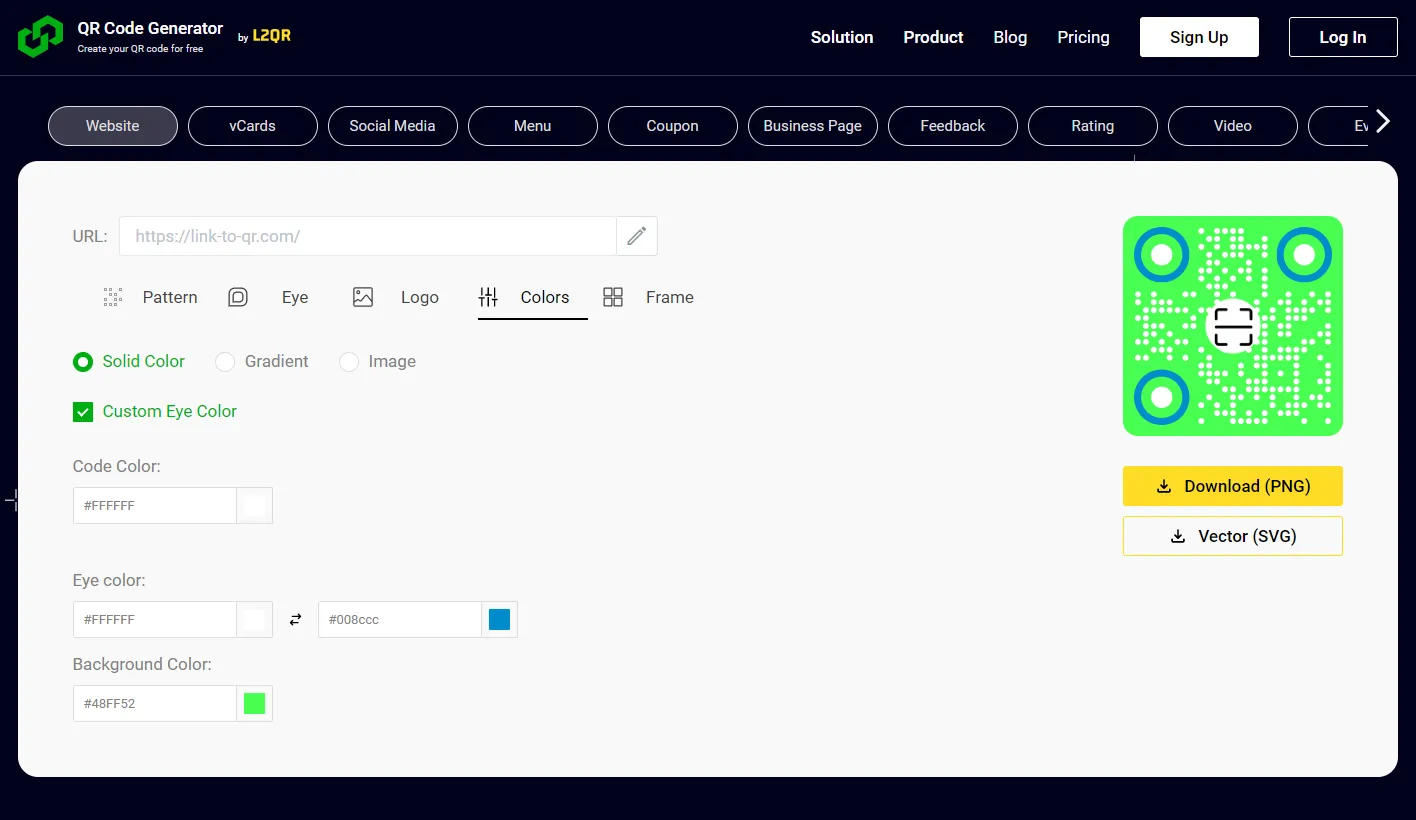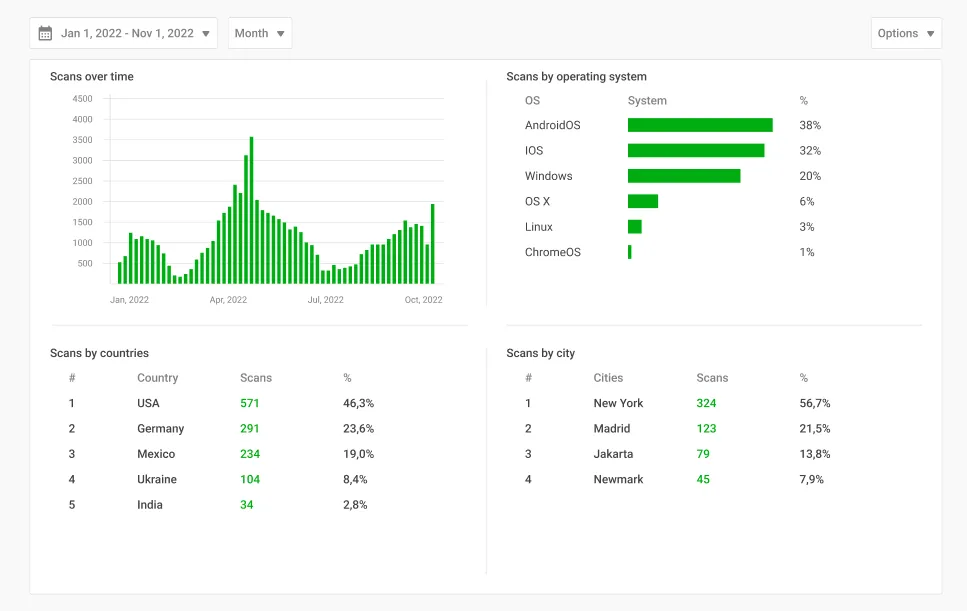

Table of Contents
1.
What is Geoposition Tracking?
2.
The Relevance of Customer Geoposition Data
3.
Real-World Applications
4.
How to track geopostion of scans of your QR codes?
5.
Conclusion
Introduction
Geoposition tracking, the process of monitoring the location of customers in real-time, has become a valuable tool for businesses seeking to understand consumer behavior and improve their services. In today's data-driven world, the ability to pinpoint the geoposition of customers provides a wealth of information that can drive decision-making and enhance customer experiences. One of the innovative ways this is achieved is through the use of QR codes.
What is Geoposition Tracking?
Geoposition tracking involves tracking the precise location of an object or individual on the Earth's surface using a combination of technologies, such as GPS, Wi-Fi, and cellular networks. In the context of businesses, it primarily pertains to tracking the movements of customers.The Relevance of Customer Geoposition Data
In today's highly competitive business landscape, understanding your customers on a granular level has become a paramount objective. Customer geoposition data, which reveals the precise locations and movements of individuals, provides a wealth of valuable insights that can significantly impact a company's success.
Consumer Behavior AnalysisCustomer geoposition data allows businesses to gain deep insights into consumer behavior. By tracking the locations customers visit, the frequency of their visits, and the duration of their stay, companies can paint a detailed picture of customer preferences and habits. For instance, a coffee shop owner can discover that a significant portion of their customers frequently visit a nearby bookstore. Armed with this information, the coffee shop owner can explore partnerships with the bookstore or tailor marketing campaigns to attract book enthusiasts.
Targeted Marketing StrategiesOne of the most potent applications of geoposition data is in the realm of marketing. Armed with information about where customers spend their time, businesses can deliver highly targeted and location-specific marketing campaigns. For example, a retail store can send real-time promotions to customers' smartphones when they are in close proximity to the store. This not only increases the chances of a purchase but also enhances the customer's shopping experience by offering personalized discounts.
Optimized Store LayoutsUnderstanding foot traffic patterns within a physical store is crucial for optimizing store layouts and product placements. Geoposition data can reveal which areas of the store receive the most attention and which are often overlooked. Retailers can then rearrange their products and displays to capture more attention and boost sales. This data-driven approach to store design enhances customer satisfaction and maximizes revenue potential.
Enhanced Customer ExperiencesThe ability to provide customers with tailored experiences based on their geoposition data can significantly improve customer satisfaction. For instance, in the hospitality industry, hotels can greet guests with personalized amenities or services based on their location within the hotel premises. This not only creates a memorable experience but also strengthens customer loyalty.
Efficient Resource AllocationGeoposition data can also aid businesses in optimizing their resource allocation. By understanding where and when customer demand is highest, companies can allocate staff, inventory, and other resources more efficiently. This prevents overstaffing during slow hours and ensures that there are enough resources available during peak times, ultimately leading to cost savings and improved service quality.
Competitive AdvantageIn today's data-driven world, the effective use of geoposition data can provide a significant competitive advantage. Businesses that harness this data can make more informed decisions, respond quickly to changing customer preferences, and stay ahead of their competitors.
Real-World Applications
Retail and Marketing:
- Targeted In-Store Promotions: Retailers use QR codes to trigger discounts or promotions when customers scan codes located near specific product displays, encouraging impulse purchases.
- Customer Journey Analysis: QR codes help retailers analyze the customer journey within the store, identifying areas where customers spend more time and optimizing those sections for increased sales.
- Pop-Up Store Insights: Pop-up stores can leverage geoposition tracking to understand customer traffic flow and adjust their layouts for maximum engagement during limited-time events.
Hospitality Industry:- Contactless Check-In: Hotels use QR codes to enable contactless check-in. Guests scan a code on their mobile devices, receive room keys digitally, and proceed directly to their rooms, enhancing convenience and safety.
- Restaurant Ordering: In restaurants, guests can scan QR codes on tables to access digital menus, place orders, and make payments, reducing physical contact with menus and servers.
- Attraction Recommendations: Tourist destinations provide QR codes at landmarks, museums, and scenic spots. Visitors scan these codes for information, audio guides, and local attraction recommendations based on their current location.
Healthcare:- Patient Check-In: Hospitals and clinics can use QR codes to streamline patient check-in processes. Patients scan a code upon arrival, providing their geolocation, which helps staff manage appointments and reduce wait times.
- Asset Tracking: Healthcare facilities can track the movement of valuable medical equipment within their premises, ensuring efficient utilization and preventing loss or theft.
Education:- Campus Navigation: Educational institutions can use QR codes for campus navigation. Students and visitors scan codes at key locations to access maps, event information, and course schedules tailored to their current location.
- Library Resource Locator: In libraries, QR codes on bookshelves or study areas can direct users to related resources, such as e-books, research materials, or online databases.
Transportation and Logistics:- Parcel Tracking: Logistics companies use QR codes to track parcels and packages throughout their journey, providing real-time updates to customers about the status and location of their shipments.
- Public Transportation: QR codes at bus stops or subway stations can offer commuters real-time schedules, route maps, and information about nearby attractions, improving the overall commuting experience.
Tourism and Hospitality:- Event Management: Event organizers can use QR codes to manage large gatherings efficiently. Attendees scan codes for access control, event schedules, and location-specific information.
- Hotel Keyless Entry: Beyond check-in, QR codes can be used for keyless entry to hotel rooms, making it convenient for guests while ensuring security.
Entertainment and Sports:- Stadium Experience: Sports stadiums and entertainment venues use QR codes to enhance the fan experience. Fans can access exclusive content, order concessions for delivery to their seats, and participate in location-based contests.
- Scavenger Hunts: Event organizers create QR code-based scavenger hunts in amusement parks or city-wide events, guiding participants to various locations and offering rewards for completing challenges.
Agriculture:- Crop Monitoring: In precision agriculture, QR codes on crops or farm equipment can provide location-specific data on soil conditions, crop health, and maintenance requirements, aiding in efficient farming practices.
- Livestock Tracking: QR codes on livestock can help monitor the health and movement of animals, enabling farmers to ensure their well-being and manage their herds effectively.

L2QR
The QR code platform offers effective e-marketing solutions
Create your QR code design that will meet your brand standards with colors

How to track geopostion of scans of your QR codes?
Embarking on the journey of crafting your own art QR code is an exciting endeavor that doesn't require advanced design skills or a hefty budget. With a few simple steps, you can infuse your creative vision into a QR code that aligns perfectly with your brand. Here's how:1. Sign up on Link-to-QR.com
Go to link-to-qr.com. Our platform offers an intuitive and user-friendly interface for generating QR codes with a personalized touch for free.
2.Generate a Tracking QR CodeAfter logging in, select the option to create a tracking QR code. This code will not only redirect users to your desired URL or content but also provide data on the location and time of each scan.
3.Provide the Destination URLSpecify the URL or content you want your QR code to link to. In your case, if you want to track menu scans, the URL could lead to a digital menu PDF or a webpage with menu details.
4.Customize the QR Code (Optional)Depending on the service you're using, you may have the option to customize the QR code's appearance. You can choose colors, add your logo, or incorporate design elements while ensuring that the code remains scannable.
5.Generate and Download the QR CodeOnce you've configured your tracking QR code, click the "Generate" or "Create QR Code" button. The service will generate the QR code, and you can typically download it in a common image format like PNG or SVG.

6.Distribute the QR Code
Print the QR code on physical materials like menus, flyers, or posters if applicable. You can also share the QR code digitally via email, social media, or your website.
7.Track QR Code ScansAs people scan your QR code, the tracking service will collect data on each scan, including the geolocation and timestamp. Access this data through your account dashboard or reporting tools provided by the tracking service.
8.Analyze DataRegularly review the tracking data to gain insights into where and when your QR code is being scanned. This information can help you understand customer engagement, popular locations, and the effectiveness of your QR code marketing efforts.
9.Adjust Marketing StrategiesUse the geoposition data to refine your marketing strategies. For example, if you notice that the QR code is frequently scanned near a specific location, consider running targeted promotions or advertising campaigns in that area.
10.Ensure Privacy ComplianceIt's crucial to handle location data responsibly and in compliance with data protection regulations. Be transparent about data collection and usage in your privacy policy, and ensure that customer consent is obtained when necessary.
Conclusion
In conclusion, the integration of QR codes into geoposition tracking has indeed revolutionized the way businesses understand and interact with their customers. This powerful tool not only provides a window into customer behavior but also offers a pathway to enhancing services and fostering growth.
However, it's worth emphasizing that the responsible and ethical implementation of QR code geoposition tracking is paramount. Businesses must prioritize customer privacy and data security, ensuring that data collection and usage adhere to legal and ethical standards. Transparent communication with customers about how their data is being utilized fosters trust and ensures compliance with regulations.
When approached thoughtfully and with a commitment to safeguarding privacy, QR code geoposition tracking becomes a catalyst for innovation and improvement across various industries. It empowers businesses to make informed decisions, tailor experiences, and ultimately forge stronger connections with their customers. In this era of data-driven insights, QR codes stand as a beacon of possibility, guiding businesses toward greater success and customer satisfaction.